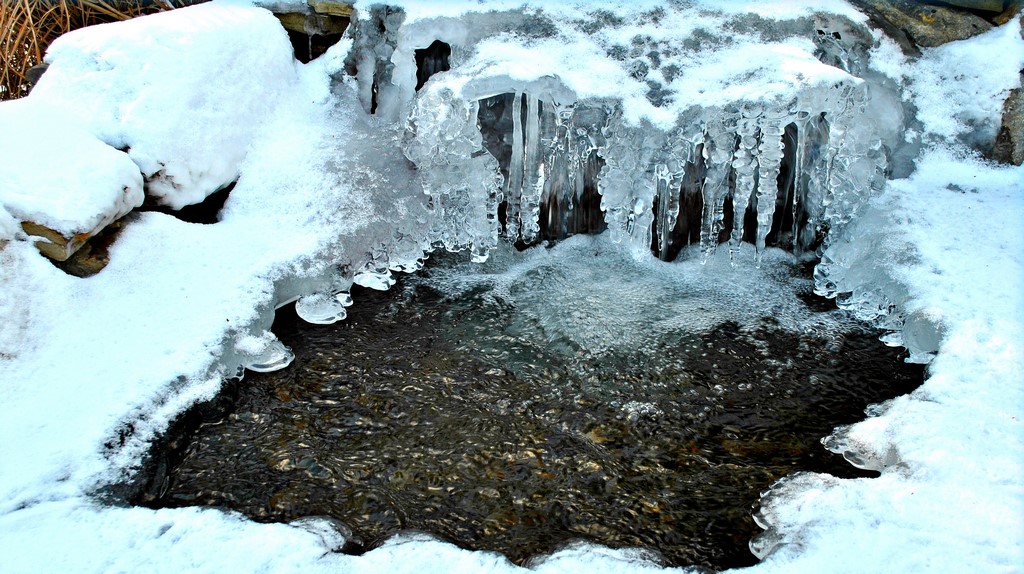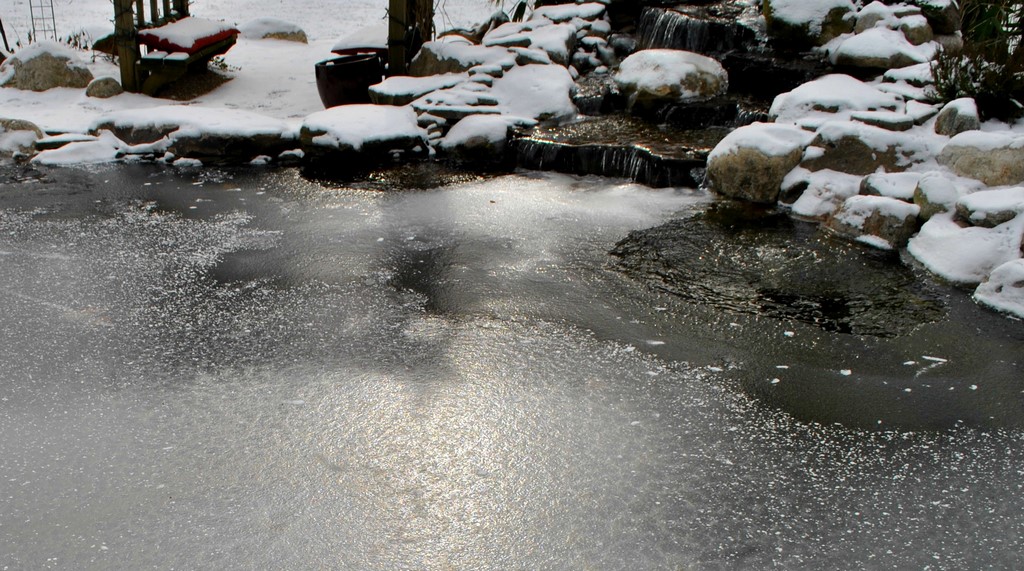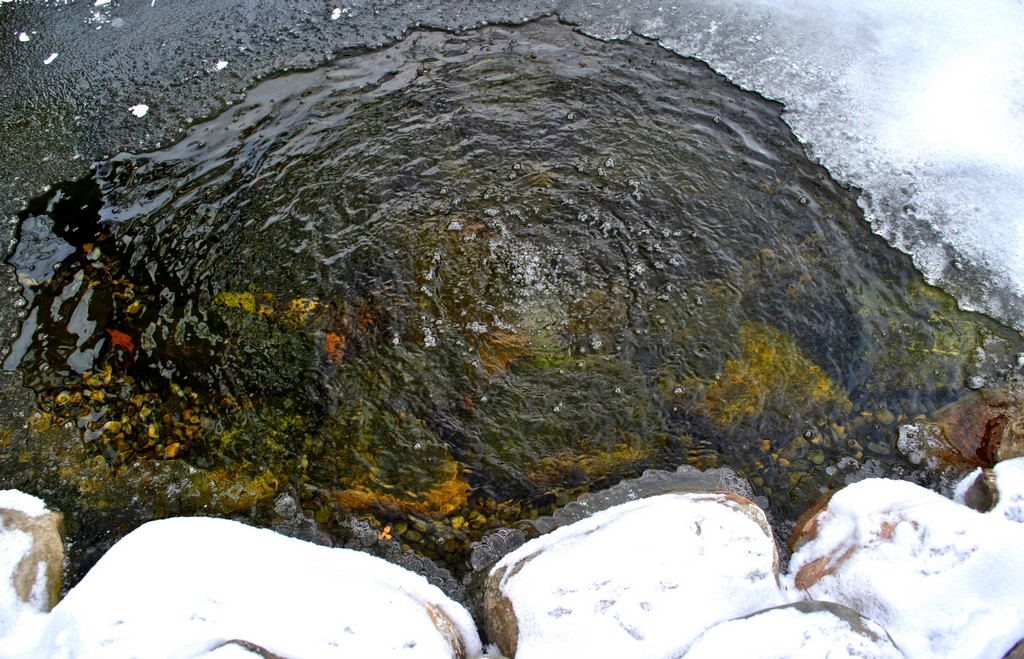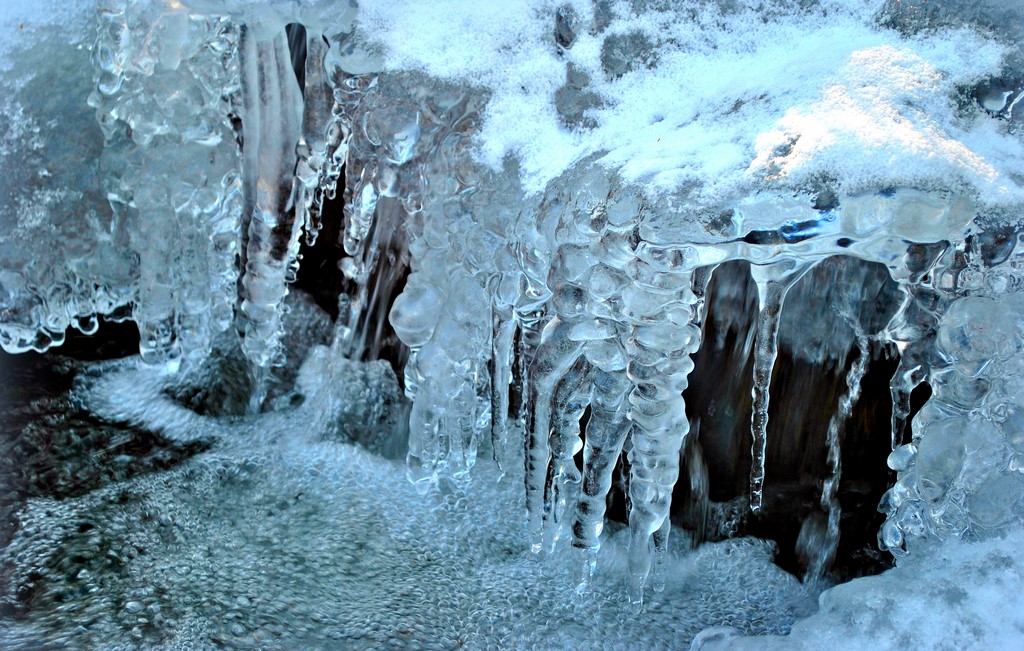Ponds and Ice
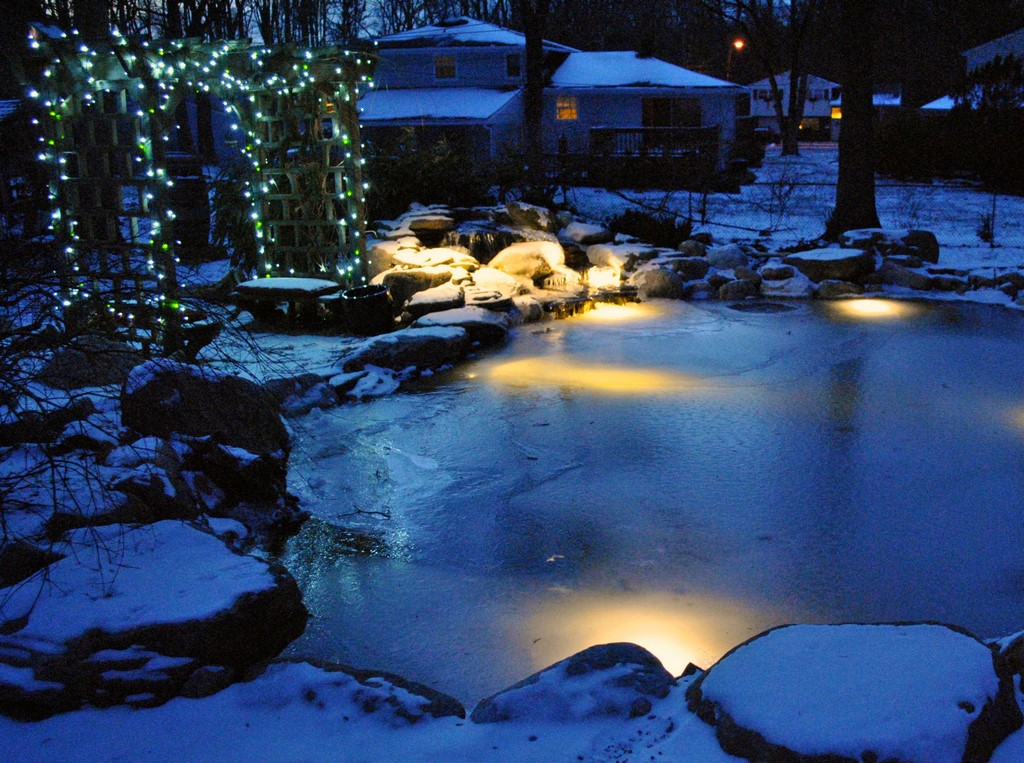
Ponds in winter are uniquely charming. Where they teem with life and activity through the spring, summer and fall, they slow down when the weather gets cold – but never so much so that they lose their ability to surprise and delight.
It’s the seasonal changes that bring a welcome sense of drama to these settings when the days are cold and short: Super-clear one morning, snow-covered or crazed with ice the next, in winter these watershapes offer up daily levels of textured, luminous variety that I see as unmatched in other seasons.
With winter’s glories, however, comes a certain need for attention at a time when working in the great outdoors may be the last thing anyone wants to do. We’ll look at what’s involved in these simple tasks in this article, but before we get there, let’s run quickly through what needs to happen before winter settles in to make cold-weather activities more tolerable – and speedy.
GETTING READY
Seasonal changes do indeed present challenges to pond environments – and that’s particularly true in the fall, when Mother Nature does all she can to dump masses of dropped and wind-blown leaves and other debris into backyards in general and Koi ponds and watergardens in particular.
That’s pretty much true in the fall no matter which region a pond is located, but it’s specifically an issue where the weather gets cold – that is, in areas where the life cycle of these watershapes requires a real game plan. Whatever the specifics of that plan are for a given pond, the first item on the list should be, as winter approaches, keeping the pond clean.
| In the event of a heavy snowfall, it’s important to clear away the snow – and even more important to make certain there’s a hole in the ice to allow gasses out of the pond’s water – and let oxygen in! |
Late September or early October is a great time to begin thinking along these lines – and placing leaf netting is an ideal way to start. These things are unsightly, I’ll admit, but they only have to be there during the few weeks when leaves are falling and blowing around in quantity.
This is also a good time to examine and test the equipment set to make certain it, too, is ready for winter. And it’s time to cut back or even stop feeding the fish: When the water gets truly cold, their metabolisms slow down to a point where they don’t require the food – and the water doesn’t need the extra nutrient burden.
Waterfalls call for special attention as winter approaches. Clearing away leaves and debris from accessible nooks and crannies is a worthy activity, and it can’t hurt to give the structure a good sluicing to clear away dirt and pass the clouded water through the filtration system for several cycles to get it back to pristine, gin-clear condition.
|
Take It Easy If you find yourself caught off guard by the early arrival of extreme weather and encounter an iced-over pond or watergarden, don’t overreact! Do not try to break a hole through the ice using a pick, hatchet or hammer! Even an inch-thick ice layer can be difficult to penetrate, and there’s always the possibility, under extreme conditions, that the spot under assault is much thicker than that. What’s needed is a good hole saw. Just keep a four-inch, drill-mounted unit in your toolbox. With minimal effort, it will create a hole large enough for sufficient out-gassing with room left over to drop in a few air lines to keep oxygen levels up where they belong. — M.G. |
The operation of waterfalls should also be monitored as the weather gets colder. When a good freeze comes, the system should be shut down so the water isn’t flowing down the rockwork and onto and across a frozen surface. This exposed water can get much colder than water in the pond itself and can drive down temperatures to levels that can harm or even kill fish and plants.
Finally, if snow comes early and unexpectedly – that is, before final winter preparations have all been made – the white stuff should be cleared away as completely as possible from the surface to let sunlight reach down into the pond. An early cold snap may catch the fish before they’re good and ready; a little extra sunlight will help keep things on track.
Snow removal is also a safety issue: If the entire pond area is blanketed in white, the possibility always arises that a young child, a visiting critter or even an adult unfamiliar with the lay of the land will wander onto the pond’s surface with either disastrous or simply embarrassing (and chilling!) results. Keeping the surface clear also preserves the pond’s function as a water resource for local wildlife – until, of course, the water surface freezes solid.
None of the preparations described above are particularly onerous. The trouble is, they come at a time of year when those caring for ponds might rather be indoors running through their own preparations for the cold season ahead. But the fish must come first if they’re to survive the season and give delight again when spring returns.
BREAKING THROUGH
When winter arrives in earnest, pond care is all about temperature and the effects it has on the water.
In cold climates, Koi ponds and watergardens will inevitably start to ice over, typically starting at the edges of the pond and slowly creeping inward until a monolithic sheet develops. If the pond is 18 inches deep or deeper, ice won’t be a big problem unless or until conditions get extreme – say, if there’s an extended run of days with single digit temperatures (in Fahrenheit).
Even in less-than-extreme conditions, however – and no matter how beautiful the icy blanket that covers a Koi pond or watergarden can be – it’s agreed among pondkeepers that letting an ice sheet remain intact for more than a short period is not desirable, particularly if the pond is home to Koi, goldfish and other aquatic species. Ideally, at least a small area of the surface should be maintained in ice-free condition to allow the key processes of oxygenation and de-gassing to continue uninterrupted.
| Waterfalls can be helpful in winter de-icing and gas transmission/oxygenation, which is why it’s a good idea to place aerators and de-icers at their bases. But if the surface freezes over completely, the waterfall should be turned off to avoid flooding the pond with excessively chilled water that will thicken the ice and may cool the pond to unhealthy levels. |
Happily, there are several available options here, some of them time-tested, inexpensive and a bit on the crude side, others involving modern technology and the latest pond equipment. All require an investment of some kind and none will actually warm the pond’s water, but they all serve to keep a small area of the surface open and ice-free with very little effort.
The historical approach involves placing tightly wound bundles of straw around the edges of the pond – a practice used at least since the 19th Century and perhaps even earlier. The straw’s open reeds will not freeze to a point where they stop transmitting gas beyond the surface or cut off the flow of atmospheric oxygen down into the water. But beware: When spring arrives, the bundles are a bit of a mess to clean up. The straw will have decayed to some degree through the winter months and will be at least slimy and maybe a tad malodorous.
Another bargain-basement approach involves partially submerging plastic, two-liter soda bottles in the pond (Swimming-pool noodles and beach balls serve the same purpose.) They aren’t visually compelling, but they do allow for the transmission of gasses around their edges. I can only recommend this as a short-term solution in the event of an unexpected cold snap: These intrusions are so aesthetically objectionable that it’s an option to be used only at sudden need.
| My love for wintertime ponds is such that, in designing them in cold climates, I make a spot with a good view of the water/ice interface a destination at the water’s edge. |
Several steps up on the technology scale are the floating or sinking de-icers that are now widely available. These units actively keep an area free of ice on a Koi pond or watergarden surface; they have no moving parts and come with varying wattages depending on the specific application and conditions. Just plug one in and put it in place as recommended.
If the Koi pond or watergarden is large enough, the best technology option is a submerged pond pump that will keep the water agitated enough that the area just above it will stay ice-free in all but the most brutal runs of well-below-freezing temperatures. But use caution and be mindful of how much water is being moved and how that flow affects the whole pond: These units have the potential to be too aggressive and over-circulate the water in ways that will stress Koi and other prized fish.
Finally, there are aerators that can be called into service in de-icing ponds. These units will actively and aggressively keep an area of the surface ice-free, and will do so even in times of extremely low temperatures when floating de-icers will give up. And for those who want maximum efficiency, nothing beats pairing an aerator with a de-icer – a real source of peace of mind for pond owners.
REAPING THE BENEFITS
In considering the realities and possibilities outlined above, remember that de-icing a pond or watergarden is not the same thing as heating it: That’s a subject for a different article.
But if the need is simply to keep ice at bay and make certain a pond or watergarden stays healthy, clear and life-sustaining even when it’s hidden under snow or ice, the important thing is knowing that there several available options and combinations of options that effectively get the job done – in some cases, quite inexpensively.
| I find incredible beauty in spaces where water continues to flow in the presence of ice – especially where an aerator’s bubbles become part of the show. There’s a dramatic tension here that makes ponds a year-round source of satisfaction and fascination. |
I’m probably among the few people who will openly say that ponds and watergardens are at their most beguiling when the weather turns cold. It’s a claim I make mostly because I enjoy the way their looks change daily or even several times a day in winter – transitions not so easy to observe during other seasons.
That’s all well and good, but even more important than the visual pleasure is the fact that I know that, with a few small chores in fall, a well-maintained pond or watergarden with a hole in its ice will be a safe, healthy place for fish and other critters to await the return of warmer days.
That’s more than enough, I think, to make working outside on a frosty day worthwhile.
Mike Gannon is owner and lead designer at Full Service Aquatics, a pond installation and service specialist based in Summit, N.J. A certified Aquascape contractor, he may be reached at [email protected].











